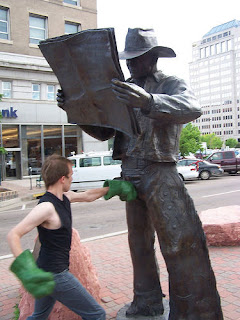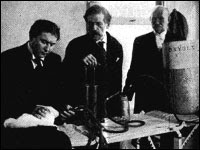Sunday, January 28, 2007
Music Without Borders
The iTunes Music Store has a secret hiding in plain sight: Log out of your home account in the page's upper-right corner, switch the country setting at the bottom of the page to Japan, and you're dropped down a rabbit hole into a wonderland of great Japanese bands that you've never even heard of. And they're nowhere to be found on iTunes U.S.... There are 20 more countries where iTunes users can lurk among the samples, including the United Kingdom, Germany, Greece, and Australia.This is all started when, jetlagged beyond belief in Tokyo, I switched on my hotel room TV and immediately heard the math-rock song "Japanistan" on MTV Japan. (Here's an audio clip.) Wow, I thought, this is really good. And then another great song, and then another, and.... Half of the lyrics I couldn't even understand, though to my surprise I could understand the other half -- turns out a lot of J-Rock fuses Japanese verses with English choruses.
It also turns out you can't find most of it in the US. Import shops and Amazon are spotty at best, and don't have audio clips: you'd have to know what you're looking for in the first place. And that's where joyriding iTunes Japan and listening to their samples comes in -- or, for that matter, iTunes France or iTunes Australia. iTunes is an unprecedented window into international musical riches that we haven't a clue about over here.
(And yes, there's a gray market way to buy from foreign iTunes...)
I've been listening to almost nothing but J-Rock for the last year. I don't know a word of Japanese, so it's quite possibly the most naive enjoyment I've had of music since junior high -- I don't know the band's reputation, haven't read the reviews, don't know what they're singing about... doesn't matter. (Hey, indecipherable lyrics never stopped Yes or Cocteau Twins.)
My Slate piece singled out "Killer Tune" by Straightener -- here they are goofing on it in the studio -- check the drummer's expression as bassist Hidekazu Hinata gleefully sabotages the video:
But more than any of the bands I cited, the real crux of the piece is simple... Holy crap, you can change countries on iTunes.
Sunday, January 21, 2007
Hulk Smash!


And, of course...

Much Depends on Pie
Upon learning that some murals newly discovered behind wainscoting at Westminster were being pulled down by remodelers, Smith began showing up there at dawn every day. Nobody else had paid much attention to the murals: nobody cared about something so ordinary. But Smith hurriedly drew newly exposed bits of mural each day before workmen came in at 9 a.m. to wreck the very work that he had just captured on paper.
Yet that sort of speed is vital in art. The quiet concentration typically needed to create a finished piece hides the fact that quick reflexes are crucial to superior artistry. There is a talent in suddenly stopping to capture the brilliant flash of the mundane. Smith recalled how engraver William Hogarth, in the middle of getting lathered at Joseph Watkin's barbershop on Tottenham Court Road, observed a boy out on the sidewalk setting down a hot meat pie too hard upon a wooden hitching post: the plate shattered, sending gravy running down the sides of the post. Hogarth sat up, and then with his head still lathered he bolted over to the barbershop window, comically intent on sketching the steaming mess outside. If someone were to ask me to describe the actual work of aesthetic observation, I might simply point to Hogarth and that smashed plate of pie: it is as true a précis of the artistic mind as the day Smith recorded it.
Saturday, January 13, 2007
Peter Rabbit and the Terrible Tea Cozies
[In 1903 Beatrix Potter created a] Peter Rabbit doll, outfitted in his signature blue coat and black shoes. This led to Peter Rabbit wallpaper and The Game of Peter Rabbit, which was essentially Mr. McGregor chasing Peter. "I think this is a rather good game," Beatrix wrote to Norman. "I have written the rules at some length, (to prevent arguments!) but it is very simple, & the chances are strongly in favour of Peter.".... In her lifetime, Potter oversaw and always had final approval on a wide assortment of spin-off merchandise, ranging from bedroom slippers to handkerchiefs to china tableware to Peter Rabbit hot water bottles. "She was always willing to think about a diary or a Peter Rabbit almanac, and the range of colouring books she designed had a coloured-in picture on one page and a simple outline on the other so children could learn to colour," explains Floyer.
In 1917, Potter wrote to her publisher: "The handkerchiefs are wonderful, I feel sure they'll have a good sale." In a 1922 letter she said: "The china is splendid, far better printed than the modern editions of the books." And another correspondence in 1926 illustrates how really into the swing of things she was: "The nursery articles mentioned in your letter this morning sound quite a good idea. I wonder if there is a crawling rug on the market with cut-out applique figures? I think they are not unknown. I've never heard anything more of that objectionable woman with the terrible tea cozies."
The Tell-Tale Lung
Namely, he was harnessing oxygen tanks to a piston-pump breathing apparatus -- he had, in short, invented an artificial respirator. He demonstrated it around the country in the 1880s by smothering and then reviving animals in front of crowds of physicians, and it landed him headlines like BRINGS DEAD TO LIFE.
GEORGE POE had little if any memory of cousin Edgar: he had been just three years old in 1849, when his famous relative was found delirious and dying on the streets of Baltimore. He had however inherited the Poe fascination with science and intoxicants; after fighting in the Civil War, George built the Poe Chemical Works in Trenton, New Jersey, where he designed America's first plant for mass producing liquefied nitrous oxide. By 1883 Poe was supplying some 5000 dentists across the country with cylinders of laughing gas, including one suspiciously enthusiastic client in Cleveland who ordered 4000 gallons. But deep inside his chemical works, Poe was pondering a question worthy of old cousin Edgar: could the dead be restored to life?

It all sounds gruesome, though Poe's concern was the eminently civic-minded one of restoring drowning and gas-inhalation victims. What the NPR piece doesn't quite get into (though it's hinted at) was that Poe's device had at least one human volunteer -- a Mrs. Harriet Martin of Chicago, who Poe turned away -- and one patient (Moses Goodman) actually saved through the Poe Respirator's use.
One big surprise was just how long various forms of mouth to mouth and bellows artificial respiration have been around -- since at least the 1400s in Italy. Yet it was not widely adopted until the 1700s:
By 1767 a society for reviving drowning victims had formed in Amsterdam. In 1774 London followed suit with the Society for the Recovery of Persons Apparently Drowned, later known as the Royal Humane Society. In the early days, the RHS concentrated on establishing riverside emergency stations equipped with respiration kits. A typical kit in 1782 included a half-litre bellows and elastic tubing, as well as a thin leather blowpipe for funnelling or blowing restorative medicines directly into the stomach. In its first 20 years, the Society records that its efforts saved 1835 lives.
Despite this, various artificial respiration techniques were not universally adopted until the 1950s; it's a medical procedure that lay in plain sight for centuries, adopted in fits and starts. And as for Poe? Due to his own ill health, he never managed to make a real go of his invention: I haven't found a word written about him since his death in 1914.
Sunday, January 07, 2007
Editing Raymond Carver: The Early Years
Why the Oregonian? Because Fisketjon grew up here in glorious Oregon:
Golf was Fisketjon's passion growing up in Salem, but the mink ranch always came first. It was labor-intensive, and Fisketjon was the laborer from the time he was 4, feeding, checking and cleaning up after hundreds of aggressive animals that love to eat and bite the hand that feeds them.
"It was hard work," Fisketjon says. "Our ranch bordered on a park, and I remember looking out and watching my friends play while I was shoveling mink (manure)."
Incidentally, Fisketjon does not recommend them as pets: "If one ever got loose, every dog and cat in the neighborhood would be dead in 24 hours."
Saturday, January 06, 2007
All Books Now Have a Chapter 11
Book publishers braced themselves for a financial blow this week after a bankruptcy filing by Advanced Marketing Services, a book distributor. The company filed for bankruptcy protection last Friday, reporting more than $200 million in debt to dozens of publishing companies. Its creditors included publishers large and small, among them Random House, which is owed $43.3 million, and Good Books of Intercourse, Pa.., which specializes in books about the Amish and the Mennonites and is owed nearly $1 million.Incredibly -- okay, not that incredibly -- yesterday's Times coverage (days late and buried on page 3 of the business section) seems to have missed the real story, which is that small indy publishers are liable to take it on the chin. The AMS bankruptcy filing only lists a hit parade of their top 40 creditors, but even at #40 it's still at $630k in amounts owed. Innumerable small publishers working with AMS and their subsidiary PGW -- just about every good small publisher you've ever heard of -- woke up in the street on New Year's morning with their clothes missing and a pair of black eyes.